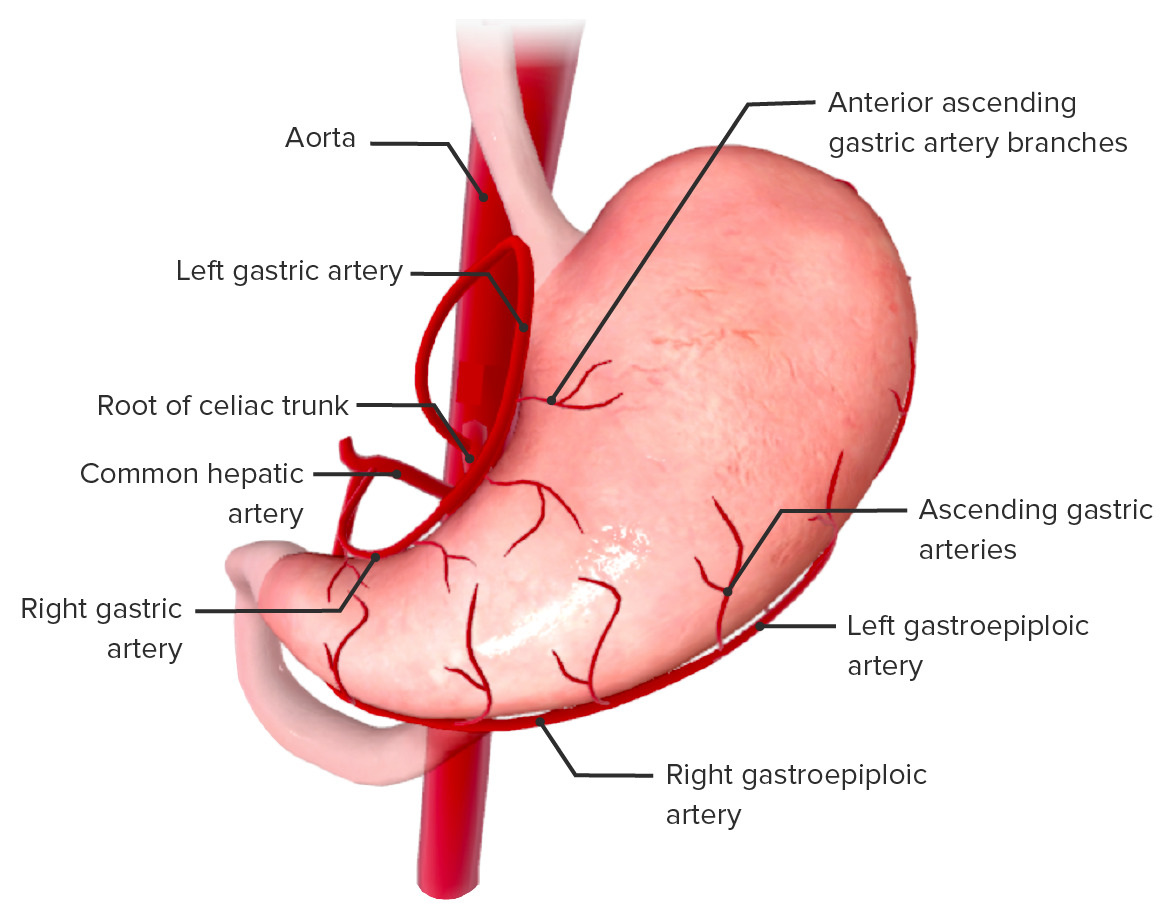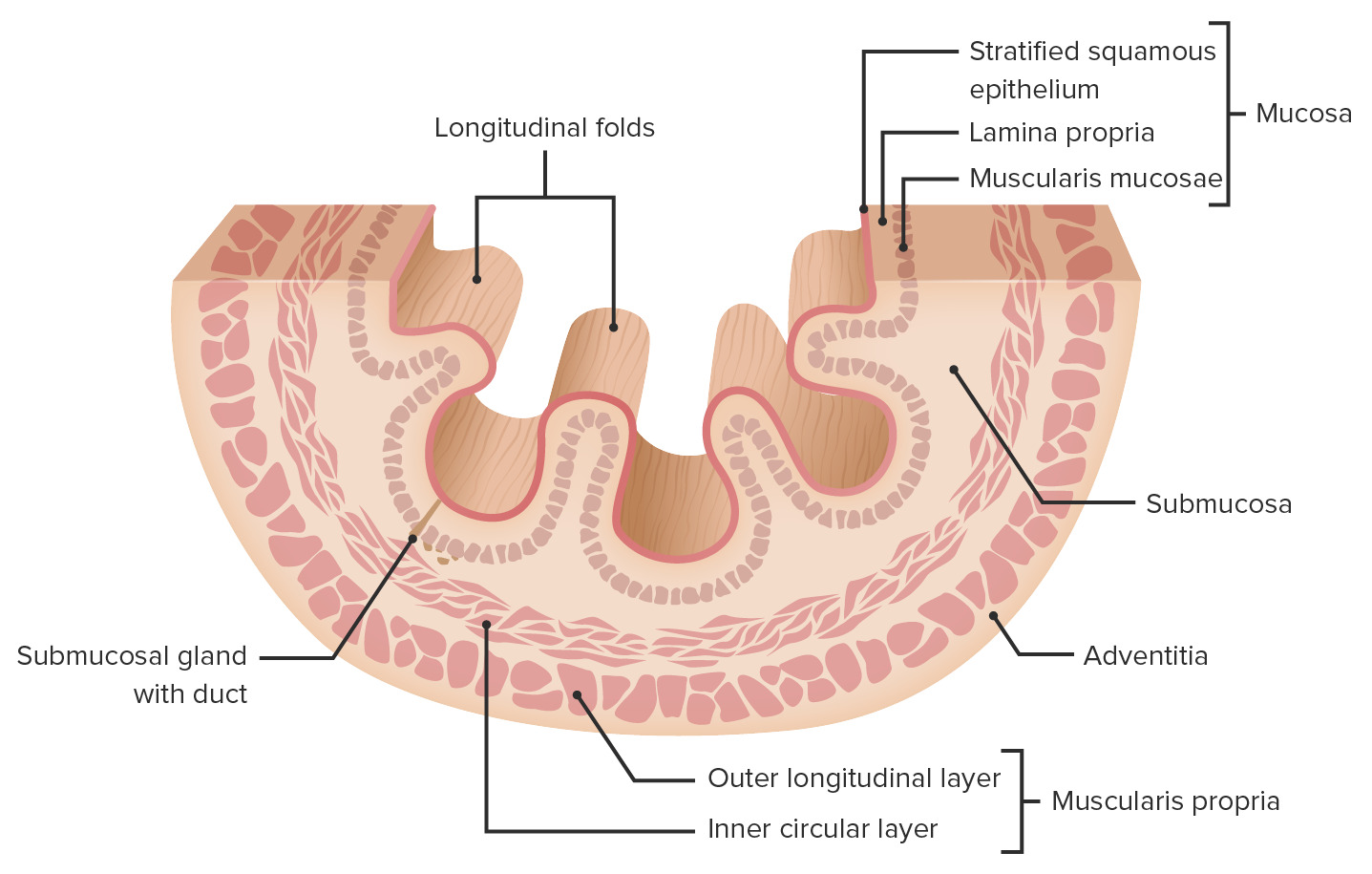Playlist
Show Playlist
Hide Playlist
Stomach Ulcers
-
Slides Stomach Ulcers.pdf
-
Reference List Anatomy.pdf
-
Download Lecture Overview
00:01 So now we're familiar with the basic structure and some functional aspects of the stomach, let's have a look at a little bit more detail but through the prism of stomach ulcers. You've probably heard of someone with a stomach ulcer that can be really quite painful and quite debilitating. To do that, we need to look at the microstructure of the stomach. So we need to cut through the wall and see some of these gastric folds, some of these rugae. And you can see those here. So these undulations are the rugae, the gastric folds and they form the mucosa. We have a submucosa, we can see various blood vessels there. And then we have a muscularis externa region which has got these nice smooth muscle fibers that help to control and regulate the movement and the contractibility of the stomach. Let's have a look at the mucosa in slightly more detail. So here we can see we've got the mucosa and the various undulations. We can see that these undulations are lined by epithelium. And actually leading into these little channels we have gastric pits and these can be where various sounds within the epithelium can discharge various gastric juices, proteins, etc. 01:05 etc. and importantly some hydrochloric acid. At the bottom of these rugae, we have what are known as gastric glands. And these have a number of different types of cellsing. One of which is known as the chief cells and these secrete pepsinogen. Now pepsinogen is an inactive form, but it's known in its active form as pepsin, and we'll cover that in a moment or two. But these chief cells secrete pepsinogen. What we also have are parietal cells. Now parietal cells secrete hydrochloric acid and they secrete as freely formed hydrogen and chloride ions. Importantly, they reduce the stomach pH to down around 1.5 or 2. 01:50 So you can see we have a very acidic environment within the stomach. What happens with this production of acid via the parietal cells is they transform the inactive pepsinogen which is secreted by the chief cells into the active pepsin and pepsin is an important enzyme that breaks down proteins. So start of the initial digestive process is food passing from the esophagus into the stomach then the surface area of the stomach is greatly enhanced by these rugae and gastric folds. Under the bottom of them where we have these gastric glands is a balance. Chief cells secrete pepsinogen. Parietal cells secrete hydrochloric acid, lower the pH. Those 2 things work in harmony convert pepsinogen to pepsin and pepsin starts breaking down proteins. Well you also have these various mucous cells and the mucous cells are really important as you can imagine because they protect the epithelium of the stomach. And obviously what you don't want to happen is the hydrochloric acid that's being present within the stomach, yes it has a function to convert pepsinogen to pepsin but you don't actually want it to start eating away and attacking the epithelium. So the mucous cells help to line and protect the lining of the stomach. So clearly there is going to be a balance. You want the hydrochloric acid production from the parietal cells and the mucus production to balance that. If you start having an imbalance, you have increased secretion of hydrochloric acid. And then with decreased secretion of mucus, you will start having a gastric ulcer as you won't have enough mucus there to prevent the hydrochloric acid from eating away and penetrating the epithelium. If it does eat away and penetrate the epithelium, then it's going to wear a hole in it and here we can see one of those holes within the stomach lining and that's a stomach or gastric ulcer. And what you end up having is then lots of blood vessels become invested and you have bleeding out into the abdominal wall. You may have bleeding out into the peritoneal cavity and have bleeding out into the stomach itself and you'll start coughing and vomiting out blood.
About the Lecture
The lecture Stomach Ulcers by James Pickering, PhD is from the course Anatomy of the Esophagus and Stomach.
Included Quiz Questions
In relation to the stomach, at which position do the kidneys lie?
- Posterior
- Anterior
- Lateral
- Medial
- Superior
A patient seen in the emergency department complains of severe abdominal rigidity, fullness, and rebound tenderness and is found to have a fever. The patient states a history of nonsteroidal anti-inflammatory drug (NSAID) use due to arthritis and denies having black stools. Which condition is the patient most likely to have?
- Peritonitis
- Appendicitis
- Hemorrhage
- Cholecystitis
- Pancreatitis
Customer reviews
5,0 of 5 stars
| 5 Stars |
|
5 |
| 4 Stars |
|
0 |
| 3 Stars |
|
0 |
| 2 Stars |
|
0 |
| 1 Star |
|
0 |





